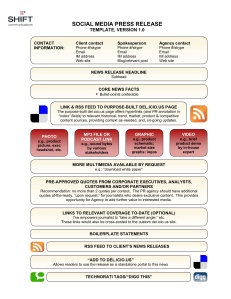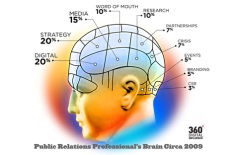The classic public relations press release – a traditional public relations device, once paraphernalia for print journalists, has evolved to a way that can be applied more into the online world. I call it the birth of social media magic.
The social media release originated from a blog post back in late February 2006 by blogger and former Financial Times correspondent Tom Foremski titled, “Die! Press Release! Die! Die! Die!” Foremski complained that traditional press releases were narrative exercises in spin that took time to deconstruct and reassemble into a story of interest to his readers.
Foremski offered several suggestions, which SHIFT Communications principal Todd Defren took to heart, so much so that, May 23, 2006 brought about the unveiling of the first social media press release template.
 Although this template still holds true as a great guideline, a lot has changed since 2006 in the realm of social media in public relations.
Although this template still holds true as a great guideline, a lot has changed since 2006 in the realm of social media in public relations.
A recent study by the Society for New Communications Research (SNCR) found that most releases now target consumers and customers directly, rather than through the filter of the news media. The study also provides rich insight into how successful the incorporation of a SMR can be.
“Another goal of the study was to provide insights as to how public relations professionals can understand these changes in order to work more effectively with journalists,” SNCE pointed out. “[Also to] provide more value to the journalistic community.”
Public relations analysts Brian Solis and Deirdre Breakenridge describe a social media release as “the opportunity to share news in ways that reach people with the information that matters to them, in ways that they can easily use to digest and, in turn, share with others through text, links, images, video, bookmarks, tags, and so on, while also enabling them to interact with you directly or indirectly.”
The same company that developed the first template offered this updated version 1.5 in April 2008:
Jeff Mascott, of the Washington, D.C.-based PR firm Adfero, led a workshop addressing some basic guidelines for writing a social media release.
Who does a social-media release target? SMRs simultaneously target three types of audiences, Mascott said:
- Traditional, mainstream journalists
- Bloggers and other digital influencers
- The general public
Mascott points out that SMRs should be written for three types of readers:
- Real people
- Search engines
- Social-networking sites
Where do I put a social-media release? Solis and Breakenridge recommend putting SMRs on a blogging platform such as WordPress, or on Facebook, LinkedIn and Twitter accounts.
Keep headlines short. Make sure the headlines are no longer than 80 characters, Mascott counsels. “If you want something that’s going to be shared, a long bureaucratic headline is not going to generate any word-of-mouth or traffic on social-media websites,” he says. Ask yourself, “If this appeared on Facebook, would I click on it?”
Tell a story. “Write like a person and not an organization,” Mascott says. Get rid of the marketing-speak and craft a narrative you’d like to read in the newspaper.
Aim for “diagonal” readers. “Diagonal” readers take in a story in 10 seconds or less. “People don’t read an article like they read a book,” Mascott explains. “There’s an awful lot of scanning going on.” To help readers hit the most important points, Mascott offers the following:
- Subsection headers. Search engines can also index a story more effectively if the story is broken up into subsections and write a subtitle for each section using keywords.
- Boldface. Search engines appear to pick up on bolded and underlined words better than plain fonts.
- Pictures, graphs and summaries. Make key concepts easy to grasp.
Create multimedia objects. Creative use of video, photos and interactive objects can be embedded and shared. Rather than including a quote within the story, Mascott offers to consider recording a video of an executive making the statement and uploading it with a transcript.
Provide resource links. Link to executive bios, company fact sheets, downloadable logos, and a delicious or Digg page that aggregates articles supporting — or even opposing — the point of view. These features are timesavers for journalists and bloggers, making them more likely to turn your SMR into a story.
Make sharing easy. Ensure the release syndicates to RSS readers, shows up error-free when pulled into Facebook, Twitter or other sites, and comes in a printer- and e-mail-friendly version. Include one-click buttons for popular social-media sites at the bottom of your SMR. If you don’t have an IT person to help, go to a DIY site such as AddThis.com or ShareThis.com to generate embeddable code.
Make feedback easy. Include a section for moderated comments at the bottom of your release. SMRs are all about fostering dialogue about your news.


#1 by Dr. G on November 23, 2010 - 6:45 pm
Impressive post full of interesting and useful tips. Looks like a good suggested reading for a future Campaigns class…